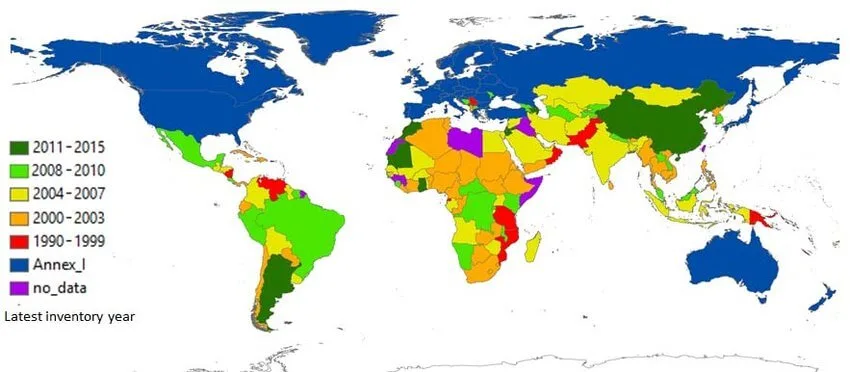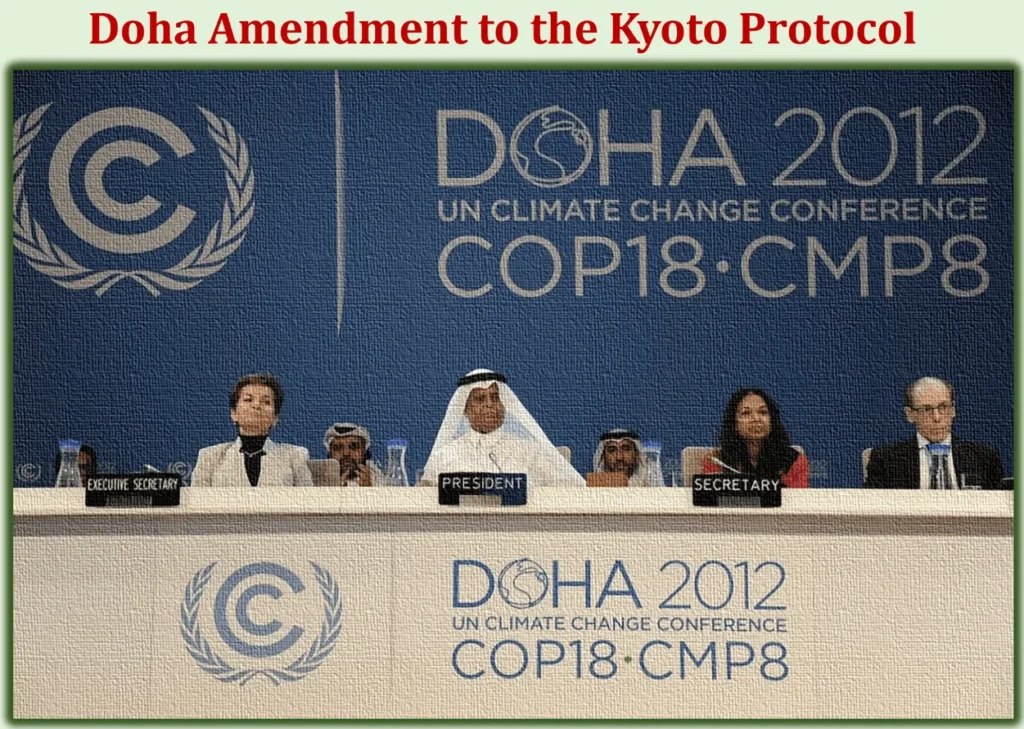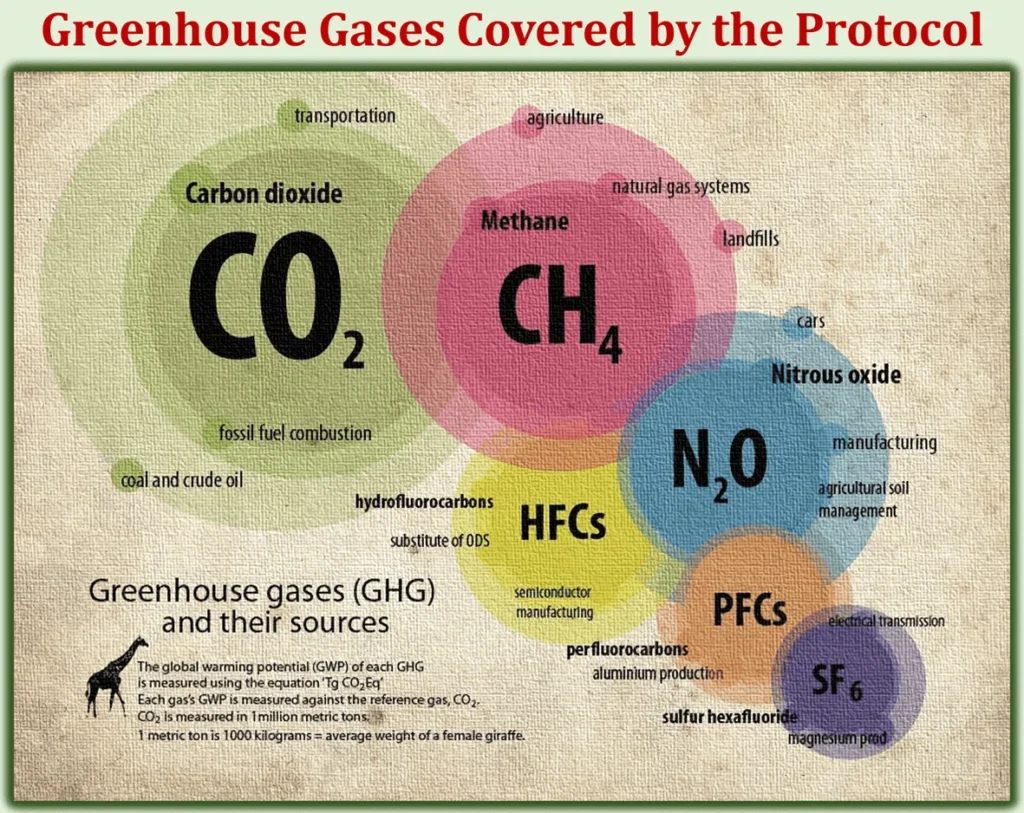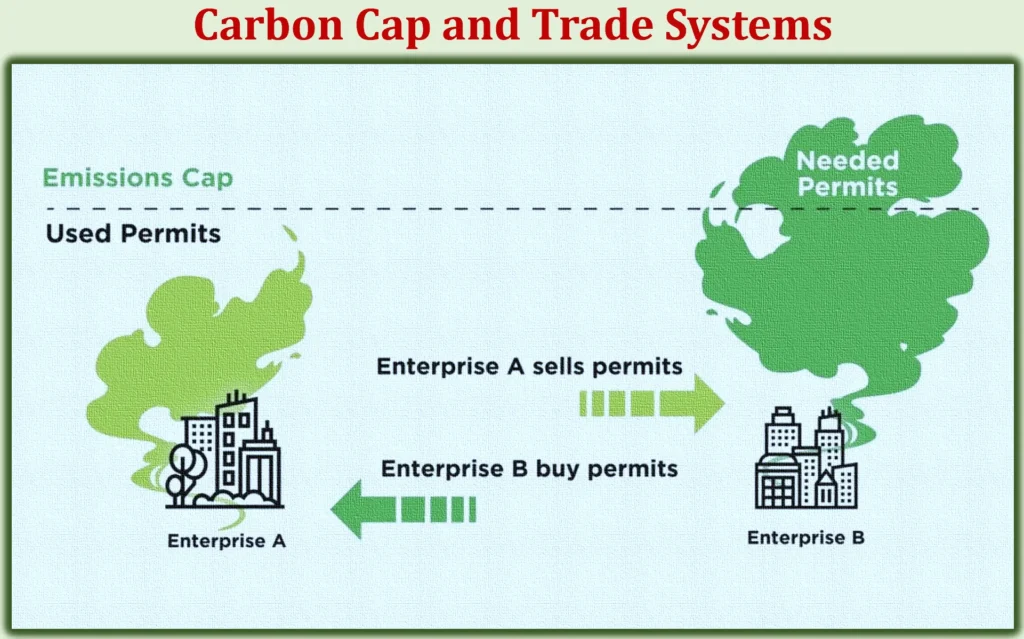
Introduction to Kyoto Protocol
The Kyoto Protocol is a global agreement designed to address the pressing issue of climate change. Its significance lies in its role as a blueprint for climate action, providing a framework for nations to reduce greenhouse gas emissions, promote renewable energy sources, and assess vulnerabilities. The Kyoto Protocol was a pivotal moment in the fight against climate change, was formally adopted on 11 December 1997.
However, its journey to fruition was not without hurdles, as it took until 16 February 2005 for the complex ratification process to be completed, with 192 Parties ultimately signing on to the agreement. Understanding the origins, objectives, and structure of the Kyoto Protocol is essential to comprehending its impact on the fight against climate change.
Background and Significance
The history of climate change awareness traces back to the late 19th century when scientists began to recognize the potential consequences of human activities on the Earth’s atmosphere. As concerns grew, the international community realized the urgency of a collective response. This led to the emergence of the Kyoto Protocol, adopted in 1997 as an important milestone in global efforts to mitigate climate change.
Operationalizing Climate Change Commitments
In essence, the Kyoto Protocol gives the United Nations Framework Convention on Climate Change vitality by requiring industrialized countries and economies in transition to make legally enforceable commitments. Unlike the Convention, which focuses on urging policy adoption and periodic reporting, the Protocol mandates specific targets for greenhouse gas (GHG) emissions reduction.
An Annex-Based Structure
The Protocol’s structure mirrors that of the Convention, employing annexes to delineate obligations. Notably, it places a heavier burden on developed countries, acknowledging their historical responsibility for elevated GHG levels. Annex B outlines binding emission reduction targets for 37 industrialized nations, including the European Union, aiming for a 5 percent reduction compared to 1990 levels during the first commitment period (2008–2012).

Key Objectives of the Kyoto Protocol
The Kyoto Protocol sets forth key objectives that nations should strive to achieve in order to address climate change effectively.
Reduction of greenhouse gas emissions
At the heart of the Kyoto Protocol lies the goal of reducing greenhouse gas emissions. By setting binding emission reduction targets for developed countries, it aims to mitigate the impacts of climate change. This commitment encourages nations to transition to cleaner energy sources, adopt energy-efficient practices, and implement sustainable policies.
Promotion of renewable energy sources
Recognizing the need to shift away from fossil fuels, the Kyoto Protocol promotes the use of renewable energy sources. By facilitating the transfer of clean technologies and encouraging investment in renewable energy projects, it aims to reduce dependency on carbon-intensive energy and promote sustainable development.
Adaptation and vulnerability assessments
The Kyoto Protocol acknowledges the reality of climate change impacts and the need to adapt to them. It encourages countries to undertake vulnerability assessments, identifying regions and communities most at risk from climate change effects. This information helps develop effective adaptation strategies to protect vulnerable populations and ecosystems.
Structure Implementation
To effectively implement climate action, the Kyoto Protocol provides a structured framework and guidelines for nations to follow.
Components of the Kyoto Protocol
The Kyoto Protocol consists of several components, each serving a specific purpose. These include the commitment periods, which define the timeframes in which emission reductions must occur, and the Clean Development Mechanism (CDM) enables industrialized nations to invest in pollution reduction initiatives in developing nations in order to gain carbon credits.
Ratification and participation of countries
For the Kyoto Protocol to be effective, it requires widespread participation. Countries must ratify the agreement and establish national strategies to achieve their emission reduction targets. The protocol’s success hinges on global cooperation and collective action from all nations, as climate change knows no borders.
The role of Conference of the Parties (COP)
The Conference of the Parties (COP) serves as the supreme decision-making body of the Kyoto Protocol. It brings together participating nations to review progress, negotiate further commitments, and address emerging issues. The COP plays a crucial role in keeping the Kyoto Protocol relevant, adaptive, and responsive to the evolving climate change landscape.
By following the structure and guidelines set by the Kyoto Protocol, nations can align their efforts towards a common goal, ensuring a coordinated and impactful response to climate change.
Commitments and Targets
Differentiation between developed and developing nations
The Kyoto Protocol recognizes the historical responsibility of developed nations in causing climate change and thus places different obligations on developed and developing countries. Developed countries, listed under Annex I, are required to take the lead in reducing emissions and providing financial and technological support to developing nations.
Binding emission reduction targets for developed countries
One of the key achievements of the Kyoto Protocol is the establishment of binding emission reduction targets for developed countries. These targets are based on the principle of “common but differentiated responsibilities.” Each Annex I party is assigned a specific target to reduce emissions by a certain percentage below their 1990 levels.
Flexibility mechanisms to facilitate compliance
To facilitate compliance with the emission reduction targets, the Kyoto Protocol introduced flexibility mechanisms. These mechanisms include emissions trading, clean development mechanism, and joint implementation. They enable countries to meet their targets by engaging in emissions trading or investing in emission reduction projects in other countries.
Implementation and Follow-up
Establishing national policies and legislation
To implement the Kyoto Protocol, countries are required to develop and implement national policies and legislation that align with the objectives of the agreement. This includes setting emission reduction targets, implementing measures to reduce emissions, and promoting sustainable development.
Monitoring, reporting, and verification mechanisms
To ensure transparency and accountability, the Kyoto Protocol established robust monitoring, reporting, and verification mechanisms. Countries are required to regularly report their emissions and progress in reducing them. Independent experts verify the reported data to ensure accuracy and reliability.
The Clean Development Mechanism’s (CDM) function
The Clean Development Mechanism (CDM) is an integral part of the Kyoto Protocol. It allows developed countries to invest in emission reduction projects in developing nations and receive certified emission reduction credits in return. The CDM promotes sustainable development by facilitating the transfer of clean technologies to developing countries.
Commitment Periods and Greenhouse Gases
Commitment Period (2008-2012)
Targets and commitments of Annex I parties
During the first commitment period of the Kyoto Protocol, Annex I parties committed to reducing their greenhouse gas emissions by an average of 5.2% below 1990 levels. These targets varied among countries based on their individual circumstances and capabilities.
Approved mechanisms for emission reduction
To achieve their emission reduction targets, Annex I parties could utilize approved mechanisms such as emissions trading, joint implementation, and the clean development mechanism. These mechanisms provided flexibility and cost-effectiveness in meeting the targets.
Challenges and achievements during the period
The first commitment period faced several challenges, including limited participation from major emitters such as the United States. Despite these challenges, significant achievements were made in reducing global emissions and raising awareness about the urgency of climate action.
Second Commitment Period (2013-2020) and Doha Amendment
Extension of the Kyoto Protocol
The second commitment period of the Kyoto Protocol spanned from 2012 to 2020. It aimed to ensure continuity in global efforts to combat climate change while negotiations for a successor agreement took place.
Commitments of participating countries
During the second commitment period, participating countries agreed to further emission reduction targets. However, the participation in this period was limited compared to the first commitment period, as some major emitters did not participate.
Overview of the Doha Amendment
In December 2012, the Doha Amendment ushered in a second commitment period (2013–2020), signaling renewed dedication to combat climate change. With 147 Parties ratifying the amendment by October 2020, it officially entered into force on 31 December 2020. The amendment introduced new commitments, revised GHG reporting lists, and updated Protocol articles to address evolving challenges. It also emphasized the need for increased ambition in reducing emissions and provided guidance for the implementation of new mechanisms and rules.

Greenhouse Gases Covered by the Protocol
Carbon dioxide (CO2) and its significance
Carbon dioxide is the most prevalent greenhouse gas and is primarily emitted through the burning of fossil fuels. The Kyoto Protocol acknowledges the critical role of CO2 in climate change and emphasizes the need for its reduction.
Methane (CH4) and its role in global warming
Methane is a potent greenhouse gas with a higher warming potential than CO2. It is mainly emitted from the production and transport of coal, oil, and gas. The Kyoto Protocol addresses the reduction of methane emissions to mitigate its contribution to global warming.

Nitrous oxide (N2O) and its sources
Nitrous oxide is emitted from agricultural and industrial activities, as well as the burning of fossil fuels. It has a significant impact on both climate change and ozone depletion. The Kyoto Protocol aims to reduce N2O emissions through targeted measures.
Hydrofluorocarbons (HFCs)
Hydrofluorocarbons are synthetic greenhouse gases commonly used in refrigeration and air conditioning systems. They have a high global warming potential and are the fastest-growing group of greenhouse gases. The Kyoto Protocol includes provisions to limit HFC emissions.
Perfluorocarbons (PFCs)
Perfluorocarbons are industrial byproducts with high global warming potential. They are predominantly emitted during aluminum production and semiconductor manufacturing. The Kyoto Protocol addresses the reduction of PFC emissions.
Sulphur Hexafluoride (SF6)
Sulphur Hexafluoride is a potent greenhouse gas used in various industries, including electrical equipment. Its long atmospheric lifetime and high global warming potential make it a significant concern. The Kyoto Protocol aims to control and minimize SF6 emissions.
Other greenhouse gases and their impact
Although the Kyoto Protocol primarily focuses on the reduction of CO2, CH4, N2O, HFCs, PFCs, and SF6, it acknowledges the importance of other greenhouse gases. These include ozone-depleting substances such as chlorofluorocarbons (CFCs) and hydrochlorofluorocarbons (HCFCs).
Emphasis on biomass carbon sink
The Kyoto Protocol underscores the importance of biomass carbon sinks in mitigating climate change. By recognizing forests and vegetation as natural carbon sequestration mechanisms, it allows countries to incorporate carbon sequestered in their ecosystems into their emission reduction efforts. Through initiatives like afforestation, reforestation, and sustainable land management, nations can earn carbon offset credits, fostering biodiversity and supporting local communities. Despite challenges such as deforestation and land rights, prioritizing biomass carbon sinks represents a commitment to holistic climate action. Strengthening these efforts fosters resilience and sustainability, offering hope in the global fight against climate change.
Flexible Mechanisms and Market-Based Approaches
The Kyoto Protocol, an international agreement aimed at combatting climate change, introduced several innovative mechanisms to facilitate global efforts in reducing greenhouse gas emissions. These flexible mechanisms and market-based approaches play a significant role in achieving the goals outlined in the Protocol. In this blog post, we will examine the Clean Development Mechanism (CDM), Joint Implementation (JI), and Emissions Trading, delving into their definitions, processes, and effectiveness.
Clean Development Mechanism (CDM)
The Clean Development Mechanism (CDM) is a key component of the Kyoto Protocol, designed to promote sustainable development while reducing emissions in developing countries. Its primary objective is to enable developed nations to invest in emission reduction projects in developing countries, thus contributing to their sustainable development goals.
Definition and purpose of CDM
The CDM allows countries with emission reduction commitments to invest in projects that reduce emissions in developing countries. These projects can involve renewable energy installations, energy efficiency measures, or practices that decrease emissions from industrial processes. By participating in the CDM, developed countries can fulfill a portion of their emission reduction targets while supporting sustainable development in developing nations.
Process and requirements for project registration
A stringent registration procedure must be completed by projects in order to be eligible for the CDM. This entails proving that the project’s emissions reductions go above and beyond what would have happened in the absence of the investment. Projects must also follow sustainable development guidelines to guarantee that the efforts benefit the surrounding people. To guarantee legitimacy and openness, the registration procedure also includes an independent validation and verification mechanism.
Benefits and criticism of CDM
The CDM offers several benefits, including technology transfer, financial investments, and capacity building in developing countries. By attracting clean technology investments, it can enhance local economies and contribute to poverty alleviation. However, critics argue that the CDM may favor projects that provide short-term emission reductions, rather than addressing long-term sustainability. Additionally, concerns have been raised about the integrity of some projects, with instances of double counting or questionable additionality.
Joint Implementation (JI)
Joint Implementation (JI) is another flexible mechanism under the Kyoto Protocol that allows developed countries to collaborate on emission reduction projects. Through JI, countries can invest in projects within other developed nations to meet their emission reduction targets.
Understanding Joint Implementation
Joint Implementation enables countries with emission reduction commitments to partner with other developed nations, supporting projects that result in emission reductions. It facilitates the exchange of knowledge, technology, and best practices among countries, ensuring efficient implementation of emission reduction initiatives.
Basics of project-based JI
Under project-based JI, parties involved set emission reduction targets and collaborate on the implementation of projects. These projects can encompass various sectors, such as energy, transportation, or waste management. The participating countries can then count the emission reductions achieved through these projects towards their individual targets.
Issues and limitations of Joint Implementation
While Joint Implementation offers potential benefits, it faces certain challenges and limitations. One key concern is the potential for “hot air,” where emission reductions may simply reflect a decrease in economic activity rather than genuine environment progress. Additionally, the distribution and fairness of emission reduction targets among participating countries can be a contentious issue, creating complexity in implementation.
Emissions Trading
Emissions trading, also known as cap and trade, is a market-based approach that allows countries or entities to buy and sell emission allowances to meet their reduction targets. It offers flexibility and economic incentives for emission reduction initiatives.
Concept and functioning of emissions trading
Emissions trading operates on the principle of setting a cap on total emissions and allocating emission allowances accordingly. Entities with excess allowances can sell them to those struggling to meet their reduction targets. This creates a market for emission allowances, encouraging entities to adopt cleaner technologies and practices.
Cap and Trade Systems
Cap and trade systems can be implemented at various levels, such as national, regional, or sectoral. They involve setting an overall emissions cap and distributing allowances among entities covered by the system. As entities work towards achieving their reduction targets, they can trade allowances based on market demand and prices.

Challenges and effectiveness of emissions trading
Emissions trading faces challenges, including the establishment of fair and accurate emission caps, monitoring and verification of emissions, and the avoidance of market manipulation. However, when effectively designed and implemented, emissions trading systems can provide cost-effective emission reductions, foster innovation, and promote international cooperation.
Successes, Challenges, and Future of the Kyoto Protocol
Successes and Achievements
The Kyoto Protocol, an international agreement designed to address climate change, has played a crucial role in reducing greenhouse gas emissions and promoting sustainable development. Here are some key successes and achievements of the protocol:
Emissions reduction and environmental impact
The Kyoto Protocol has been successful in reducing global greenhouse gas emissions. By establishing binding emission reduction targets for developed countries, it encouraged the implementation of various mitigation measures, such as energy efficiency improvements, renewable energy adoption, and the use of cleaner technologies. According to the United Nations Framework Convention on Climate Change (UNFCCC), the protocol resulted in an estimated 5.2% reduction in emissions by 2012 compared to 1990 levels.
Moreover, the protocol has raised awareness about the environmental impact of human activities, highlighting the importance of transitioning to a low-carbon economy. It has sparked global conversations and inspired governments, businesses, and individuals worldwide to take action against climate change.
Promoting sustainable development
The Kyoto Protocol emphasizes the principles of sustainable development, recognizing the importance of integrating environmental, social, and economic considerations. It encourages the adoption of policies and measures that not only reduce greenhouse gas emissions but also support economic growth, poverty eradication, and the welfare of societies.
To promote sustainable development, the protocol introduced several innovative mechanisms, such as the Clean Development Mechanism (CDM) and Joint Implementation (JI), which facilitate emission reduction projects in developing countries. These mechanisms not only help reduce emissions but also promote technology transfer, capacity building, and investment in clean technologies in developing nations.
Strengthening global climate governance
The Kyoto Protocol has played a crucial role in strengthening global climate governance. By establishing a legally binding agreement with clear emission reduction targets, it sent a powerful signal to the international community about the urgent need to address climate change. It paved the way for subsequent international climate negotiations and agreements, such as the Paris Agreement, which built upon the foundation laid by the Kyoto Protocol.
Furthermore, the protocol established a robust framework for monitoring, reporting, and verification of emissions, ensuring transparency and accountability among participating countries. This framework has enabled countries to track their progress and assess the effectiveness of their climate policies and measures.
Challenges and Criticisms
While the Kyoto Protocol has made significant contributions to the global fight against climate change, it has also faced challenges and received criticisms. Some of the main challenges and criticisms are:
Non-participation of major emitters
One of the key criticisms of the Kyoto Protocol is the non-participation of major emitters, such as the United States, China, and India. These countries account for a significant portion of global greenhouse gas emissions, and their absence from the protocol limits its overall effectiveness. Without their active participation, the protocol’s impact on global emissions is diminished.
However, it’s important to note that some major emitters, including China, have implemented their own ambitious climate policies and targets outside the Kyoto Protocol framework.
Limited coverage and scope of the protocol
Another criticism levied against the Kyoto Protocol is its limited coverage and scope. The protocol primarily focused on developed countries and did not include binding emission reduction targets for developing nations. As a result, some argue that it created an imbalance, as developing countries’ emissions have been rapidly increasing in recent years.
To address this imbalance, the Paris Agreement introduced a more inclusive and balanced approach. It requires all countries, developed and developing alike, to contribute to global emission reduction efforts.
Monitoring, reporting and verification issues
The Kyoto Protocol faced challenges in effectively monitoring, reporting, and verifying emissions reduction efforts. Some countries lacked the necessary capacity and resources to accurately measure and report their emissions. This led to concerns about the reliability and accuracy of the reported data.
To improve the monitoring, reporting, and verification process, the Paris Agreement introduced enhanced transparency and accountability measures. It requires countries to regularly submit detailed reports on their emissions, progress towards their targets, and climate policies and measures.
Transition to the Paris Agreement
Overview of the Paris Agreement
The Paris Agreement, adopted in 2015, is a landmark international climate agreement that aims to strengthen the global response to climate change. Its objectives are to keep global warming well below 2 degrees Celsius above pre-industrial levels and to work toward keeping the rise in temperature to 1.5 degrees Celsius.
Unlike the Kyoto Protocol, the Paris Agreement includes participation from all countries, establishing a common framework for both developed and developing nations to take climate action. It also emphasizes the importance of adaptation, finance, and technology transfer in addressing climate change.
Relationship between Kyoto Protocol and Paris Agreement
The Paris Agreement builds upon the principles and foundations laid by the Kyoto Protocol. It recognizes the importance of continuing the efforts initiated by the Kyoto Protocol and encourages countries to ratify and implement both agreements.
While the Kyoto Protocol focuses on emission reduction targets for developed countries, the Paris Agreement takes a more comprehensive approach by requiring all countries to submit their nationally determined contributions (NDCs). These contributions outline each country’s climate goals, including mitigation and adaptation measures.
Future of international climate action
The transition from the Kyoto Protocol to the Paris Agreement marks a significant milestone in international climate action. It reflects a growing global consensus on the importance of collective and cooperative efforts to combat climate change.
The future of international climate action lies in the implementation of the Paris Agreement and the strengthening of global cooperation. It calls for increased ambition in emission reduction targets, enhanced support for developing countries, and continued innovation and deployment of clean technologies.
Conclusion & FAQs
The Kyoto Protocol stands as a vital blueprint for climate action, offering a comprehensive framework for nations to tackle the challenges posed by climate change. It emphasizes the reduction of greenhouse gas emissions, the promotion of renewable energy sources, and the importance of vulnerability assessments. With a structured implementation plan and the involvement of all nations through the Conference of the Parties, the Kyoto Protocol provides a pathway towards a sustainable and resilient future.
The fight against climate change relies on the collective commitment of individuals, communities, governments, and organizations worldwide. As we strive for a greener planet, let us remember the lessons and guidance offered by the Kyoto Protocol. By understanding and implementing its principles, we can create a better future for generations to come.
“The Kyoto Protocol paved the way for international climate action, inspiring governments and individuals worldwide to take significant steps towards a sustainable future.”
Frequently Asked Questions (FAQs)
What is the Kyoto Protocol’s impact on global emissions?
The Kyoto Protocol has resulted in an estimated 5.2% reduction in emissions by 2012 compared to 1990 levels. It has played a crucial role in raising awareness about the environmental impact of human activities and the urgent need to transition to a low-carbon economy.
How does the Kyoto Protocol support sustainable development?
The Kyoto Protocol promotes sustainable development by integrating environmental, social, and economic considerations. It encourages the adoption of policies and measures that reduce emissions while supporting economic growth, poverty eradication, and the welfare of societies.
Can the Kyoto Protocol alone solve climate change?
While the Kyoto Protocol has made significant contributions, it alone cannot solve climate change. Climate change is a complex and global issue that requires the collective effort of all countries. The transition to the Paris Agreement reflects the recognition that a more inclusive and comprehensive approach is needed to address climate change effectively.
What are the main criticisms of the Kyoto Protocol?
Some of the main criticisms of the Kyoto Protocol include the non-participation of major emitters, limited coverage and scope, and challenges related to monitoring, reporting, and verification of emissions reduction efforts.
What is the significance of the transition to the Paris Agreement?
The transition from the Kyoto Protocol to the Paris Agreement marks a significant milestone in international climate action. The Paris Agreement takes a more inclusive and balanced approach by requiring all countries to contribute to global emission reduction efforts. It emphasizes the importance of adaptation, finance, and technology transfer in addressing climate change.
